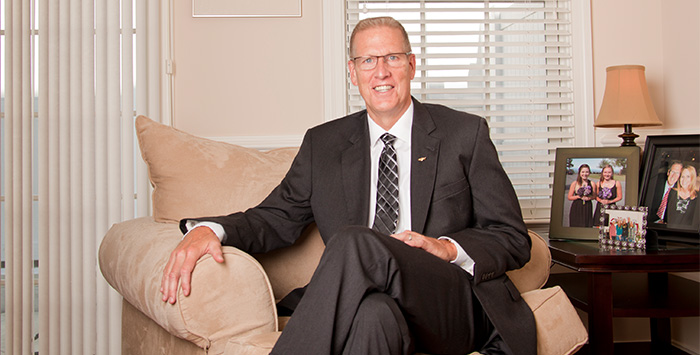Asset management on ‘autopilot’
Asset management on ‘autopilot’

Mike Jones, CRPC • Virginia Beach, VA
Patriot Strategic Investments • ProEquities, Inc.
While flying as a commercial airline pilot, Mike Jones built an investment advisory practice. Third-party active managers provide him and a growing number of financial advisors with research-driven strategies—a controlled and systematic approach to portfolio management.
Proactive Advisor Magazine: Mike, how would you describe your client base?
I think I have a fairly unique perspective and different career path from most advisors. I have been a financial advisor since the early 2000s and have received my Chartered Retirement Planning Counselor designation. But I also spent nine years on active duty in the Marine Corps, was a lieutenant colonel in the Marines Reserves, and now have over 20 years as an airline pilot. During all of those career phases, I have built up a large network of friends and colleagues, many of whom have employed my services as a financial advisor.
My clients vary in terms of income, assets, and financial sophistication. No matter what their income level, whether it is $50,000 or $500,000, I see the same issues over and over when I first sit down with a client. People tend to spend up to their income level, often neglecting to “pay themselves” first, especially when it comes to how they approach their retirement savings. My number-one priority is trying to bring discipline to the retirement-planning process and to show clients how they might grow their assets in a risk-managed fashion.

What are those retirement issues?
The biggest problem for most people—and it is well-documented in financial studies—is that they will not have enough money for the kind of retirement they envisioned, especially with increased life expectancies and health-care needs. The reasons are all over the place, including job layoffs, lower salaries coming out of the recession, the housing crisis, or simply not having developed a good plan at an early enough age.
Others may have lost a lot of money in 2008-2009 and bailed out at the wrong time, or they did not have an advisor who might have been able to put them into active investment strategies with a defensive plan for the crash. Some who used a buy-and-hold approach may have recovered by now, but look at how long it has taken. Many people were not as fortunate and just left the market with their losses and have not returned to equities.
Consequently, a lot of people will have to work longer than they planned and rely on Social Security as an important part of their retirement. But I also think it is never too late to get things back on track, and that is what I focus on for each individual or couple.
How were you introduced to active money management?
My real mentor in the business, whom I still work with today, was investigating third-party money managers when we were first introduced. The timing was just about perfect, and I have been able to work with him through the due-diligence process of vetting a variety of third-party managers. We both have endorsed the concept of trying to find a better way for managing clients’ money, putting a strong emphasis on risk management. I have to say, with my military and flying background, this makes sense to me on so many levels—the idea of having a solid plan in place for emergencies and worst-case scenarios. Active money management is a disciplined approach to investing with advanced mathematical tools and models, which is something that inherently appeals to me.
How do you approach clients about planning?
It is a very holistic process grounded in my training. I want to develop the big picture of where they are in their lives financially and where they want to go. I focus on the major items that can really have an impact: How have they been deploying their assets? How are their protection needs being handled? What is their basic cash flow picture? How have they been planning for things like their estate, college education, and health-care needs? Once I have that picture and a thorough understanding of their goals, I work with the client to develop a plan and recommendations that can move them toward achieving those goals.
What about the investment piece?
It obviously depends on the client and their objectives, but for most clients, the goal is to grow assets to meet their retirement needs. I think that growth can best be achieved through active money management and strategic diversification. Equities are just one part of the picture. I like to take a look at a variety of things such as high-yield fixed income, real estate, oil and gas partnerships … the whole gamut of alternatives.
What client benefits do you look for from third-party active managers?
 It starts with the fact that I think every professional has their role and area of expertise. My proficiency is putting together a financial plan with all of the elements working together. While I love the financial markets and always have, there is no conceivable way I can develop the models or systems that the best money managers have or employ the staff to monitor and analyze market developments the way our managers do.
It starts with the fact that I think every professional has their role and area of expertise. My proficiency is putting together a financial plan with all of the elements working together. While I love the financial markets and always have, there is no conceivable way I can develop the models or systems that the best money managers have or employ the staff to monitor and analyze market developments the way our managers do.
Second, the emphasis on risk management is critical. As my clients approach retirement, they really cannot afford to take a hit to their assets the way the market crashes of the early 2000s or 2008 played out. It simply depletes the working and productive assets too much at a point when they may not have the luxury of time to recover. A risk-first approach may not produce the highest returns in all markets, but it can produce more consistent and sustainable returns.
Third, the active managers I use have the ability to utilize strategies that can work with any risk profile—from the most conservative investor to aggressive. But no matter what the risk profile, the strategies we use have an emphasis on risk management, a defensive capability, and typically have multiple strategies within a client portfolio. Having a “strategy of strategies,” if you will, allows for increased diversification and the ability to emphasize or deemphasize the sectors or asset classes that are working or not working.
Finally, there is the concept of discipline. I am trying to bring a disciplined approach to my clients’ overall financial lives, and that needs to apply to their investments as well. Active money managers apply that discipline to their strategy development and execution, driving emotion and bias out of the process.
Once well-orchestrated strategies are in place, we need to let them work for clients as they are intended to do. This is consistent with my overall client philosophy of creating a plan and then faithfully executing the plan, which is really what works best over the long term.
Disclosure: Mike Jones is an investment advisory representative with Patriot Strategic Investments in Virginia Beach, Virginia. Advisory services offered through Investment Advisors, a division of ProEquities, Inc., a registered investment advisor. Securities offered through ProEquities, Inc., a registered broker-dealer, Member, FINRA & SIPC. Patriot Strategic Investments is independent of ProEquities, Inc.
Photography by Chris Winton-Stahle

